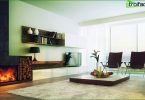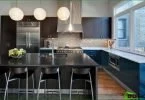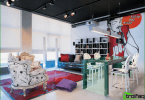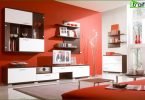The interiors of maharajas are interior design in an oriental and ethnic style that never goes out of style. Read more about how to properly arrange them.
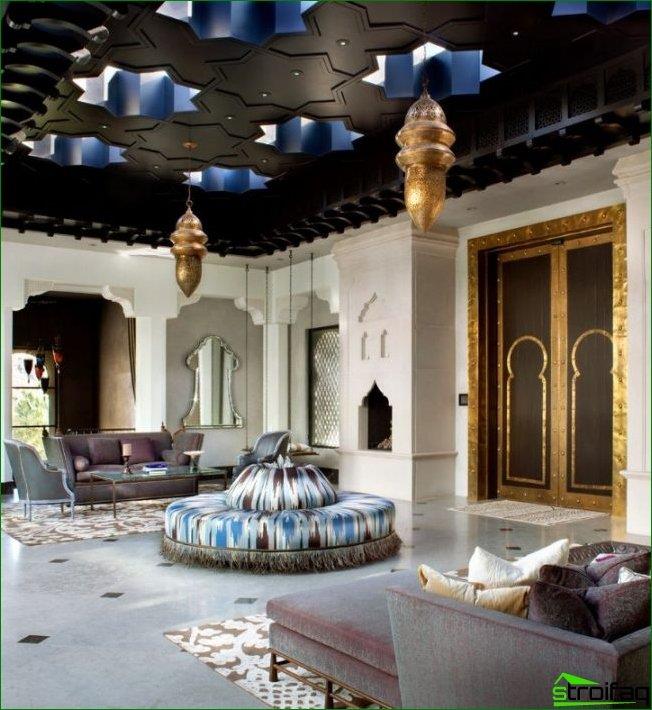
The interiors of maharajas are fabulous palaces in oriental style
Maharaja interiors – collective name oriental style in the interior, in fact, it is synonymous with luxury. However, Maharaja Maharaja is different, in fact he may turn out to be not only a Raj, but also an Arab sheikh, a Chinese or Japanese emperor, and this is a different East. Each interior will radically differ from each other with its unique features..
Content:
- The many faces of the East
- Oriental subtleties in the interior
- Oriental style kitchen interior
- Ethnic Home Furnishings
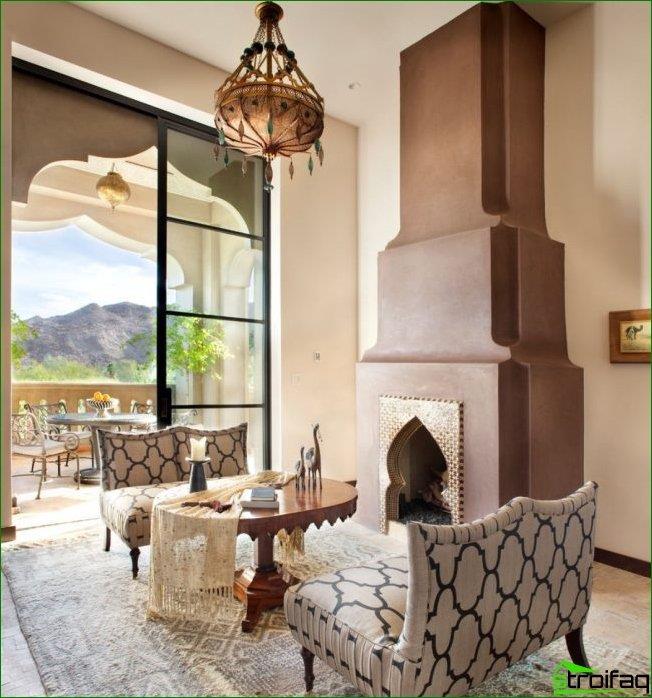
Moroccan motifs in the interior of maharajas: the predominance of light shades, arched elements and large windows
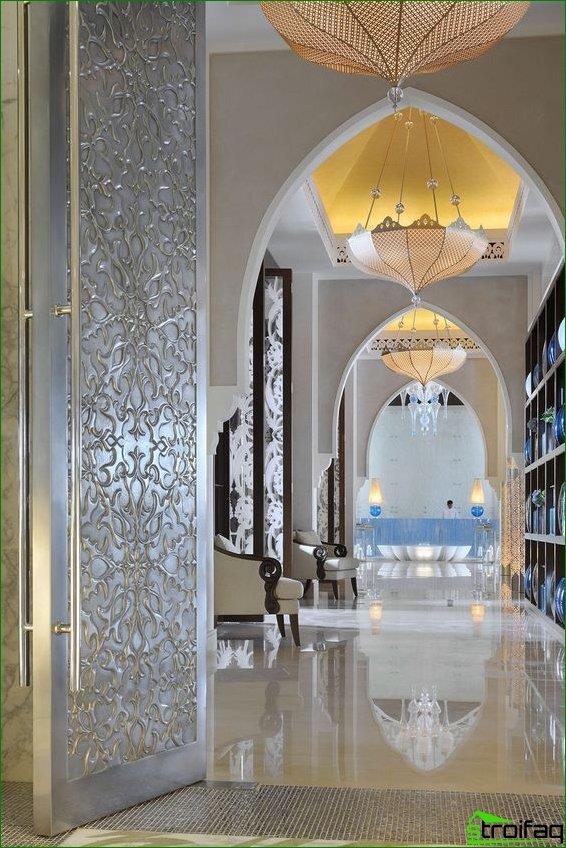
Mirrored floors, arches instead of doors and floral patterns in the interior add even more ease and “flight” to the interiors of maharajas
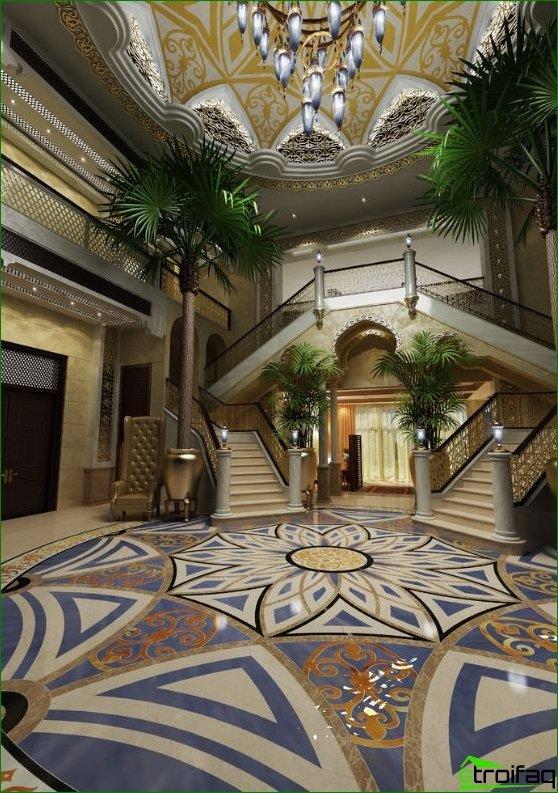
Hall in the house in the style of Maharajas: huge palm trees, high domed ceiling, stairs and floral motifs on the ceiling and floor
The many faces of the East
In general, the oriental style in the interior is divided into five areas.
Interiors of the East:
- Arabic style – The common name for the rich interiors of Islamic countries, where even the decorations go side by side with religion, and the Quran directs all movements. For example, in this holy book there are clear lists of animals and even people forbidden to represent, and therefore the leading element is neutral colors and geometry. Since the Arab countries have a very hot climate, air is used as partitions fluttering curtains. On the one hand, they are designed to conceal female beauty from prying eyes of others, on the other hand, they allow free circulation of air. It is customary for Arabs to emphasize a high social status, and therefore a lot of gold is present in the decor. The interiors are plentiful pillows, carpet, the fabric etc. Once upon a time, wood was not particularly accessible here and was literally valued at its weight in gold, because it was used to make carved partitions, decorative objects, but it was very rarely used as a material for furniture, they simply felt sorry.
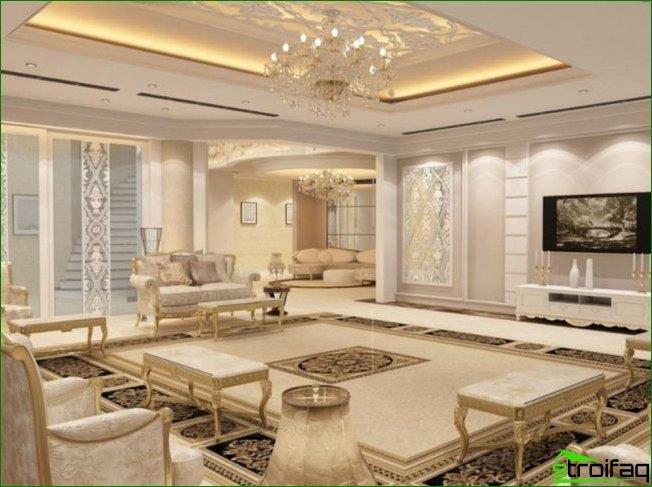
The interior of the maharjahs in the Arabic style is made in cream and sand tones. Mirror surfaces, lighting, gilding of furniture and tiles with traditional patterns can be complemented by modern technology (plasma, air conditioning, etc.)
- Moroccan style – this is a great “diplomat” who managed to combine Arab religious chic and light romantic elements Mediterranean directionI am. On the Arab side, these are rich and vibrant fabrics, an abundance of textiles in the scenery, zoning curtains, wooden crates, carved furniture, etc. The Mediterranean can be seen in the color scheme – blue-white plus terracotta, tiled floor, pointed windows with wrought-iron grills. In all this splendor, peaceful silver sets of dishes and harsh steel weapons on the walls coexist equally harmoniously.
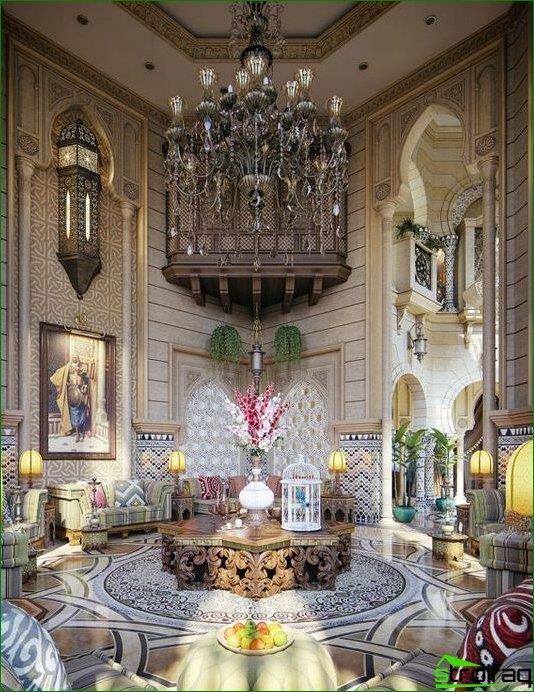
In the Moroccan style, the interior of the Maharajas surprises with wrought and carved elements, luxurious patterned lamps, painted walls, bright pillows and green plants as a decor
- Japanese style – an abundance of light and a minimum of things, strict and bright minimalism, where superiority is given to functionality, not beauty and luxury. These are sliding screens, doors, folding or built-in furniture, every detail is thought out as much as possible and is strictly in the right place. All details are perfectly emphasized by the general restrained color palette of rooms.
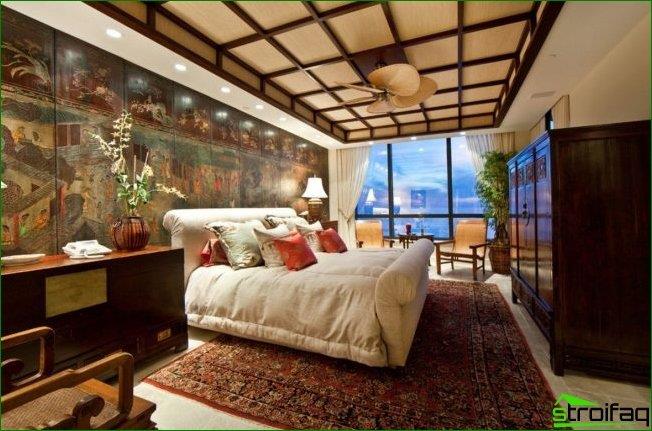
Japanese motifs in the interior of maharajas are the predominance of wood in the interior, simple lines and traditional paintings from the life of Japan
- Chinese style similar to the Japanese trend in simplicity and functionality, but restraint gave way to a love of brilliance, the main colors of the rooms – red or blue with gold. Without these shades, China is not China! An additional distinguishing feature are geometric images or drawings with favorite scenes from the palace life of the ruling dynasties. These are plots with paradise gardens, strange birds and animals, creatures from Chinese folk myths. All objects that are unnecessary or necessary, but not particularly pleasing to the eye, are cleverly hidden behind the shining ones. screens and wardrobes.
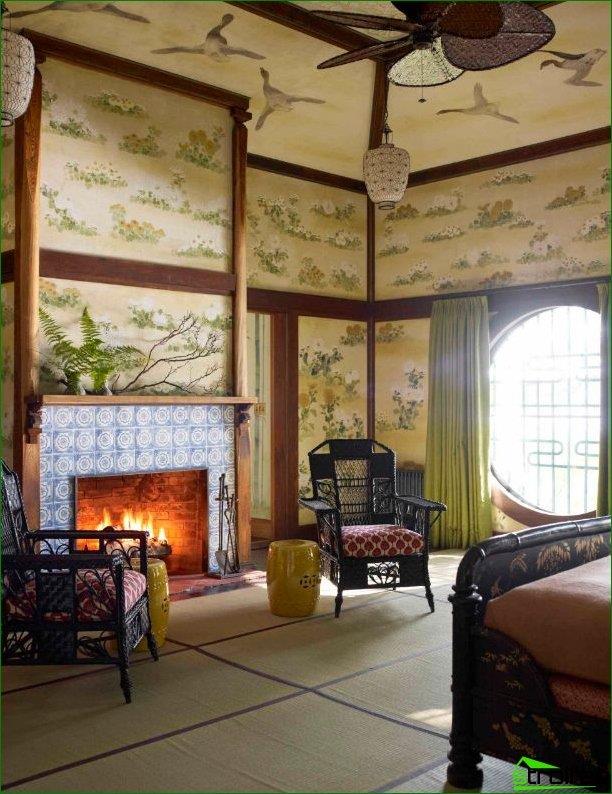
Chinese style in the interior of maharajas: images of animals on the ceiling and walls, fireplace with white and blue painting, wrought iron chairs and a round window
- About india! Hindus are adherents of measured life and yoga, they constantly meditate and strive to improve their karma. Native Indian style would require ivory, carved stone, massive columns or at least wooden carved walls. Modern India is more democratic: enough panels with imitation of natural material and natural floor. The color scheme should be sustained in warm colors – pinkish, eye-pleasing red, yellowish, brown etc. Sometimes there is a clear design in the style of gold with black, navy blue and olive shades. The rooms are traditionally filled with handmade woven carpets, they are also used as panels and bedspreads. All furniture is low and decorated with paintings or carvings; the doors resemble shutters. Chests are used instead of dressers, often used rattan furniture.
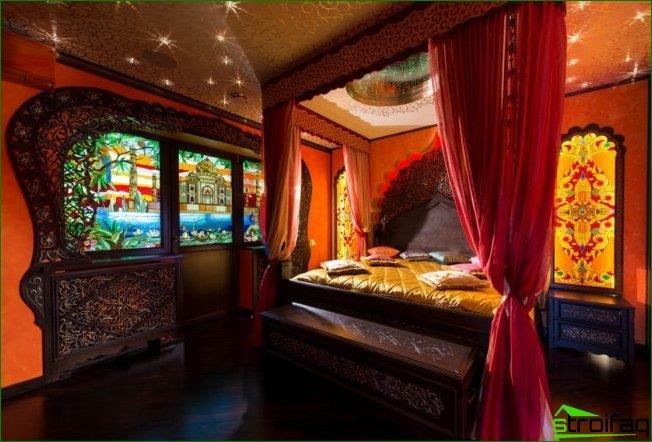
The Indian style is dominated by red colors and dark wood. Instead of a window, a stained-glass window depicting shrines can be used.
Tip! If you want to clearly arrange Indian notes, in the resting place you need to arrange not ordinary, but oblong decorative pillows – this detail vividly embodies the Indian interior!
Whatever the differences, one thing unites these styles – uniqueness with a touch of mystery. Exoticism that you want to try forever, and in the end, be sure to “bite through” all the riddles – this is what the interior is in an oriental style. Photos of rooms at first sight attract attention, take your breath away and forever remain in memory, attracting with their dissimilarity to the apartments familiar to the European look.
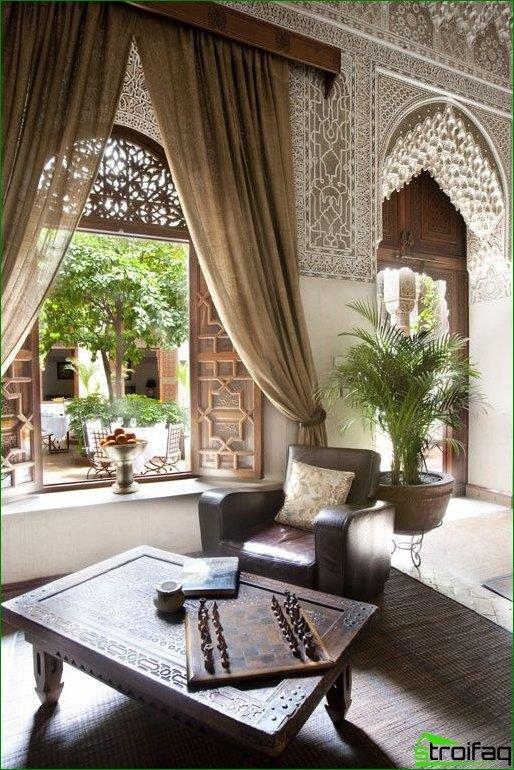
All interior styles of maharajas have common features: traditional notes of the East, high ceilings, large windows, characteristic curtains and expensive furniture
Interiors of Maharajas: Oriental Subtleties in the Interior
The interior of the room in the oriental style does not imply a rigid division into the bedroom, the living room, children’s and so on. In fact, in any of the areas zoning is used more: in the Arabic interior curtains, Japanese and Chinese – screens, in Moroccan – textiles and carved partitions.
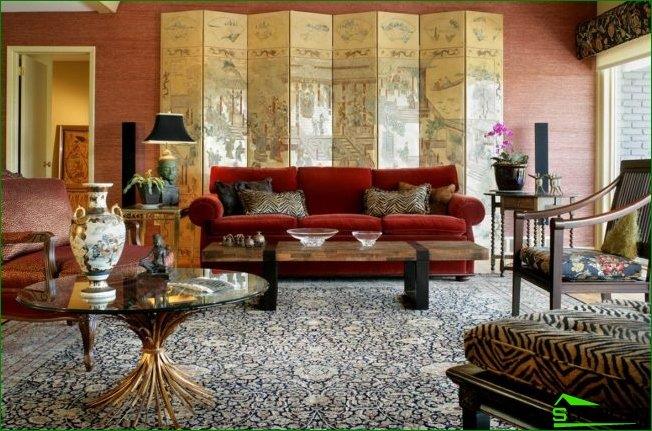
A screen in the Japanese style of the interior of the Maharajas is used both for zoning and as a decoration
Color and light
Since East to East, there is discord in order to hit the target for sure, just in case, adhere to the general intersection – warm colors and their harmonious combination. The same with drawings – geometry is loved everywhere, let it be abstract patterns. In addition to typical warm tones, you can use yellow combination from turquoise, from this the room will become brighter and more elegant.
As for lighting, any kind of interior in the East implies spaciousness and huge windows with curtains and blackout curtains on the sides. In the morning, the principle “there is never too much light” works, and by the time you relax, annoying rays per second will be muffled by a heavy curtain with gold embroidery, fringe and tassels, which, by the way, are also found in all rooms as an decoration element.
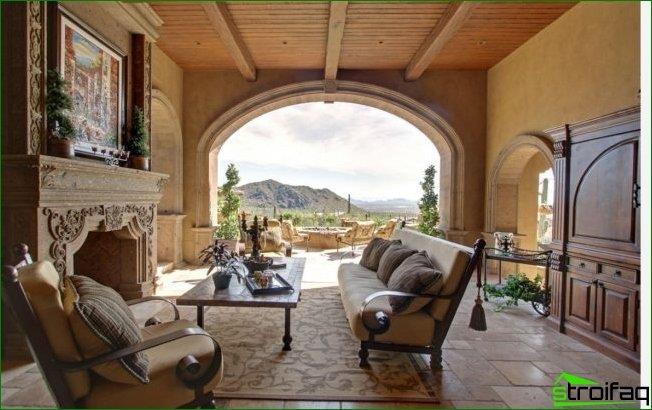
Sand colors in the finish, carved elements and access to the terrace the size of a whole wall – a living room in the interior of maharajas
Zoning
A typical division into zones in any type of oriental interior is a place for relaxation, cooking and eating. In the first center of the universe is considered a huge sofa with bright bedspread and a ton of pillows, and underneath there is a secret! Hookah is hidden there and a small table for him.
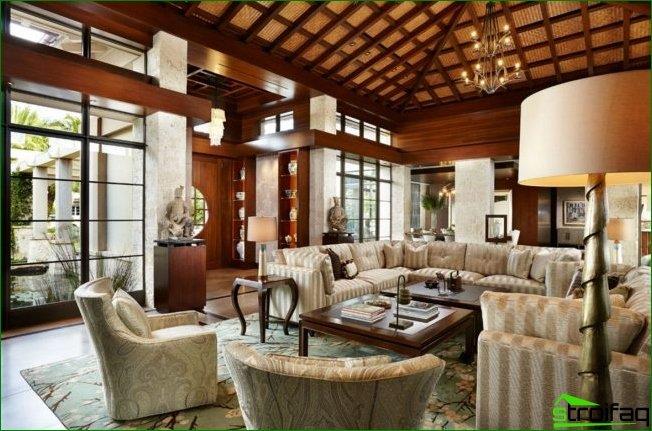
Zoning of the house in the Japanese style due to the arrangement of furniture
A special space is reserved for the meal, there should be a small low table and all the same pillows or mini poufs. Yes, in the East they don’t eat at a high table, holding their backs straight and sitting on a chair. Convenience is a priority here, eating takes place almost reclining.
Tip! If you are not used to pillows on the floor, you can use a regular table with chairs, just a table should be round, and the furniture is sew covers with oriental ornaments.
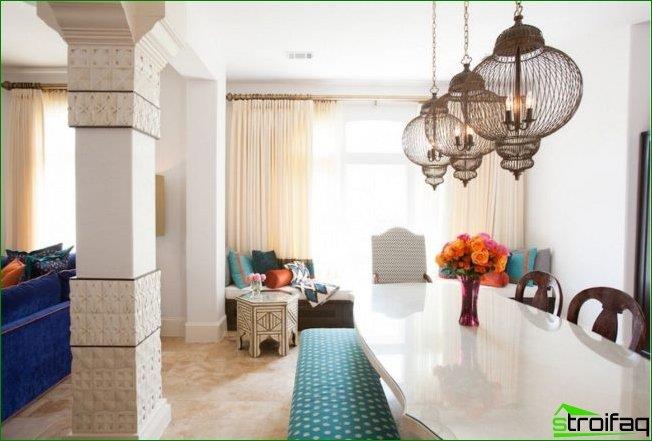
Dinner Zone in Moroccan style is separated from the living room with an arched opening. Traditional pendant lights and a vase of flowers are used as decor
The third zone is a place for cooking, it is like an invisible room, which is generally not considered a functional room, rather, it is a workplace where only servants and cooks go. But we do not live in the ancient East, but in the modern world, and therefore we cannot be so scattered by footage. Designers found a way out and showed that, taking into account our time and level of development, the cuisine of modern Maharaja and Sheikh should be!
Oriental style kitchen interior
Since our apartments rarely differ in vast area, we will also make an oriental tale from the kitchen.
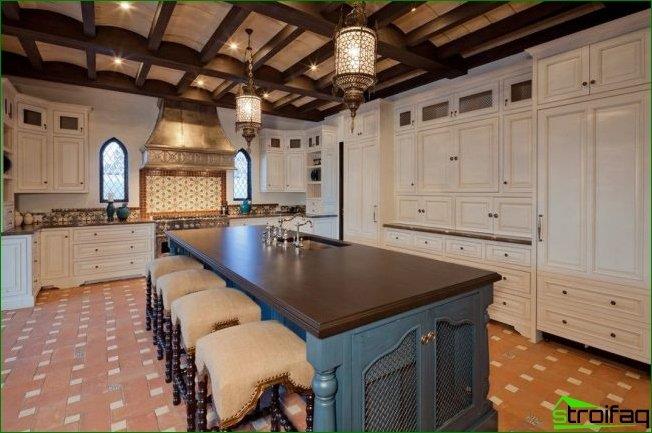
Moroccan-style kitchen: a white kitchen set contrasts with the cooking area
Finish
- Smooth walls, since curtain panels are rarely used, and mostly decorative plaster or themed wallpapers are practiced.
- Background should not be motley and high-quality, the East does not like falsehoods and imperfections, and the best painted walls. Emphasized great natural look very beautiful wooden beams.
- Instead of wallpaper, you can use a dense washable fabric with thematic drawings, and it would be better if it would be an ornament or flowers: you see, a herd of elephants, philosophically going into the sunset, would look rather strange.
- There may be wood or tile on the floor, linoleum we will say categorical “No”.
- Ceiling – no wallpaper or foam boards, only good plaster or carved hinged wooden layers.
- Windows and doors – only wood or its imitation, unfortunately, the convenience of white plastic will have to be decidedly abandoned. We use carved or just wooden shutters and the same sliding doors.
And what to do? East is a delicate matter.
With the decoration sorted out, proceed to the selection of furniture.
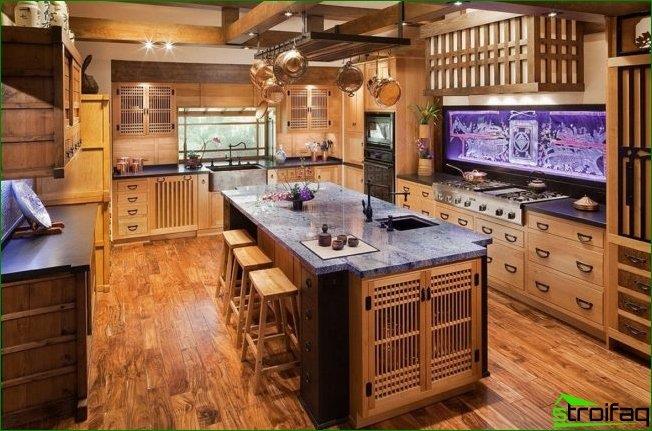
Japanese-style kitchen: using wood in decoration, kitchen unit, marble countertop and painted apron
Matching furniture
If you want a headset, it should also be wooden, but carved or simple – it depends on the choice of the direction of oriental flavor. The Chinese emperor loves simplicity and conciseness without “bells and whistles”, but give Maharaja and Sheikh monograms.
The table should definitely be round or oval, instead of chairs, ideally it is better to use chairs or at least half-chairs. In the Japanese style, everything should generally happen on the floor, but adjusted for modernity, you can simply beat furniture in strict forms and beige-black tones..
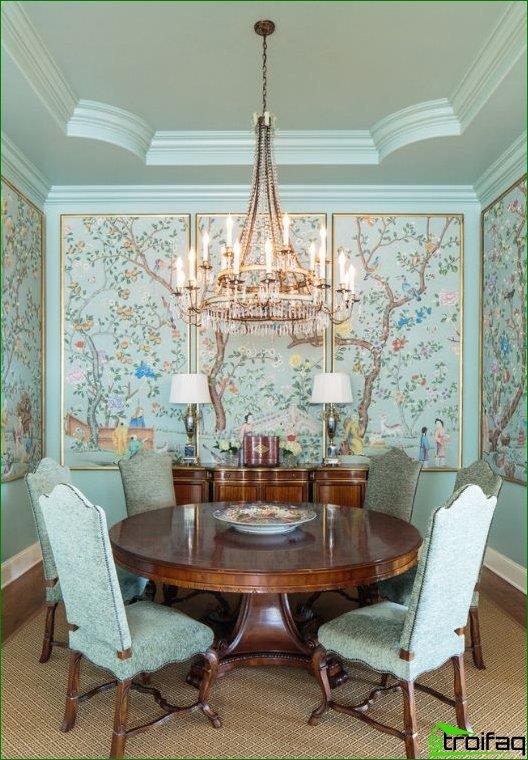
Dining area in the interior of Chinese-style Maharajas
No open shelves – the oriental interior is filled with luxury and secrets. Everything that should emphasize magnificence is displayed in advance, but lockers should be closed with daily routine.
Stove and oven. This is a kind of hearth, the energy heart of the house, and therefore a maximum of decorations is used – tiled mosaics, mirrors, food images, polished dishes made of silver and copper, exhibited on the stove as a symbol of wealth. Collectible knives can be placed on tables, even the restrained Japanese love this. In general, the heart of the house must be “rich” and pure..
Ethnic Home Furnishings
Ethnicity of the East is diverse, but there are common points.
What is the eastern flavor:
- If you bet on chandeliers and other fixtures, you can get to the point without looking. In all eastern cultures, a carved base, bead braiding, stone inlay and chasing are actively used. Carved furniture is equally revered..
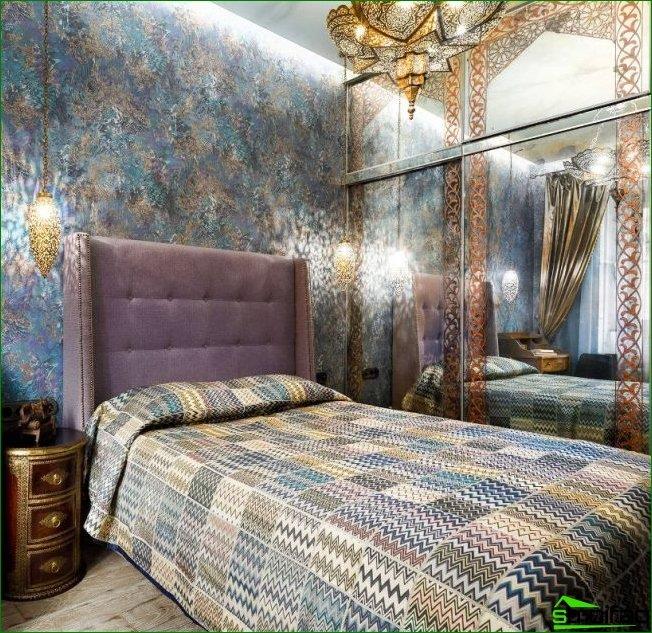
Moroccan-style fixtures amaze with grace. Textured walls, low tables and mirrors on the entire wall will help to add a touch of chic.
- Carpets are different, but the choice of the right motives becomes obvious even to a beginner. We all watched and read fairy tales, and therefore it is unlikely that we will buy a silk Chinese carpet in the Arab palace.
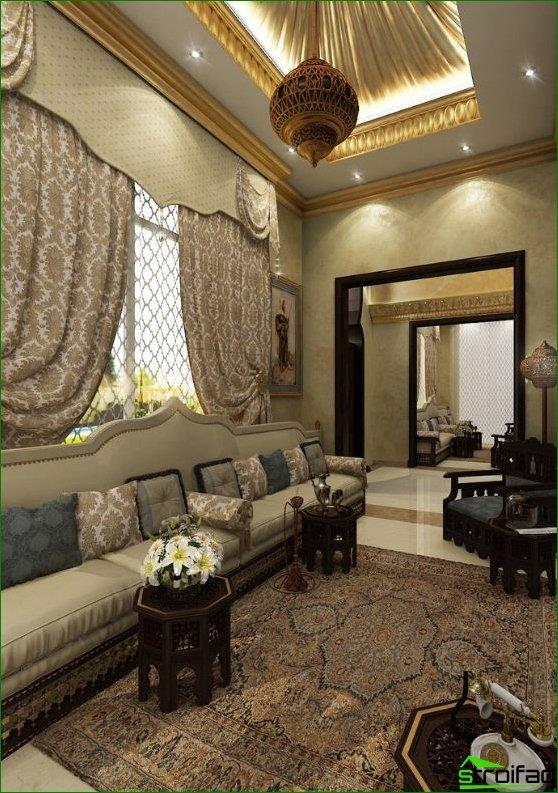
Oriental rug in harmony with pillows and curtains in the interior
- Pads, pads and pads again! They are everywhere except Japan and China. In the Arab countries and Morocco, these are square and round thoughts, in India – elongated oblong pillows, reminiscent of huge candies..
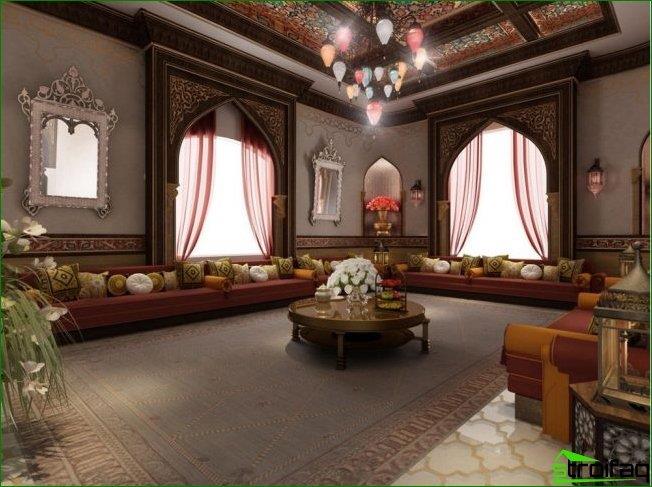
Pillows – an indispensable thing in the interior of the Arabic style
- Hookah. It is not necessary to use it, but if you conceived the style of an Arab sheikh, you should have it at least as a decoration. By the way, it will come in handy in the palace of Maharaja.
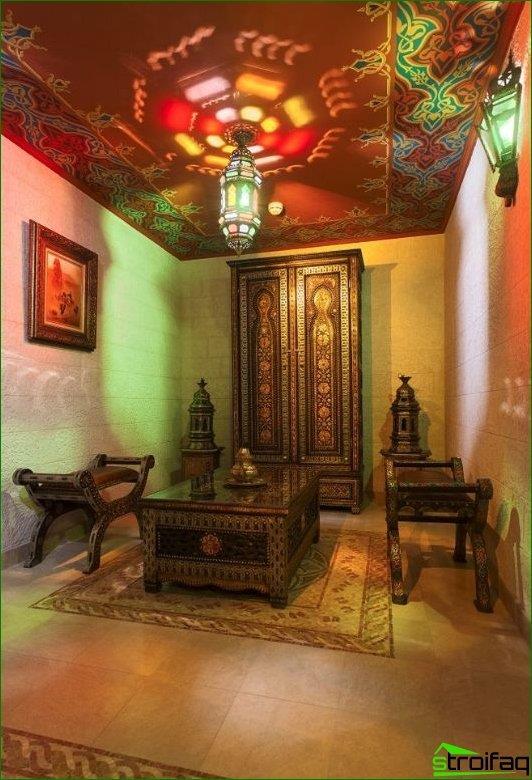
Hookah smoking room
- Dishes. Copper, porcelain and silver with unobtrusive floral images and carved “lace”.
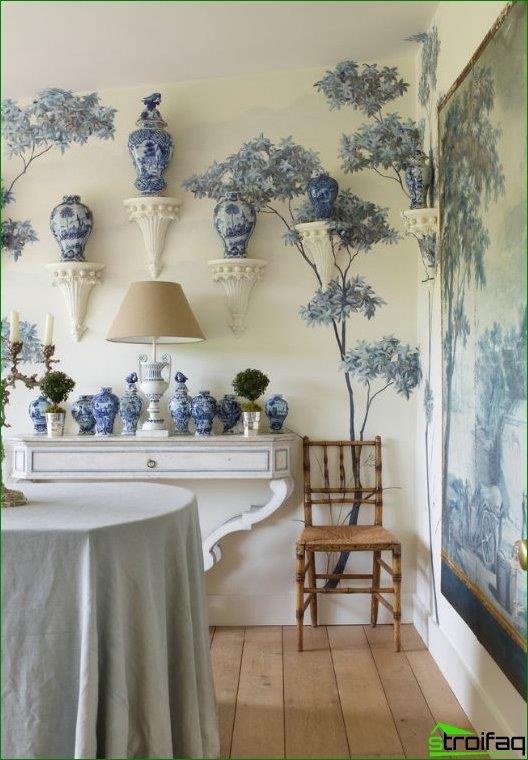
Chinese porcelain dishes can be a great addition to the dining room in the interior of the Maharajas
- And again about India. The ethnicity of this country is distinguished by its special color – statues of gods must be present everywhere, most often among the “European Indians” we can see Buddha, Shiva and Ganesha. They are all friendly and bring happiness and good luck. In addition to statues and images of deities, elephants are present everywhere, because this animal is practically a symbol of India itself, it has been revered and protected for many centuries, and therefore it is used in decorating a house.
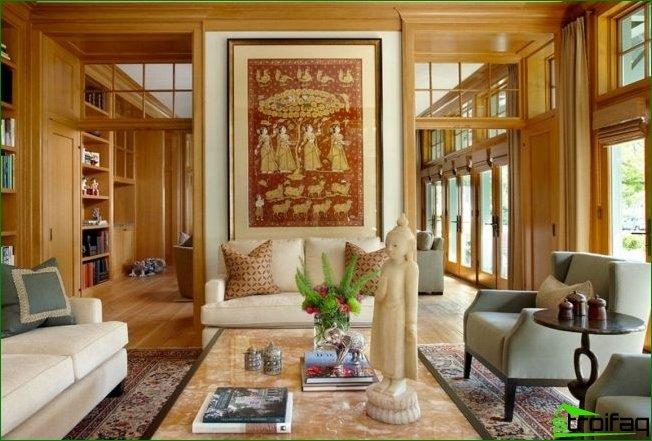
Buddha statue and statuette of an elephant in the interior in the Indian style
Tip! There are no trifles in the East, any insignificant detail is of great importance, and therefore carefully watch that an extra thing is not cluttered in the design.
Oriental style in interior design instantly captivates sensitive souls with its alluring beauty and apparent softness. Many people take it as an idea for the embodiment of their fantasies, which have remained in memory since reading unusual oriental tales and myths. Leave one room as the “pearl of the East” or complete apartment interior in oriental style, it is up to the owners to decide – it all depends on the scale of their love for oriental motifs. But, having taken up the design yourself, remember that the East is really a delicate matter, and strict rules hide behind external softness: it does not endure cumbersomeness and fuss.



